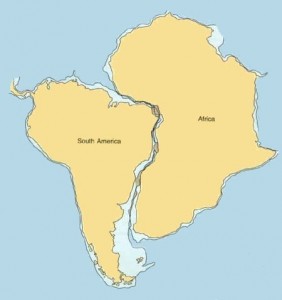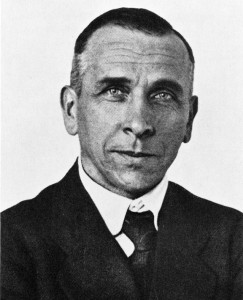It was no mystery that Africa and South America appear to fit together like a jigsaw puzzle. This was observed and noted as early as 1596 by Abraham Ortelius (Continental Drift). As time progressed, other forms of evidence emerged supporting that the continents were once joined as one. In the mid 1800’s, Antonio Snider-Pelligrini acknowledged that the same plant fossils were in the coal beds of Europe and North America at places where the continents seemed to have fit together geographically (Plate Tectonics: Continental Drift). With the addition of more evidence, some members of the scientific community began to believe that the continents were in fact not fixed in place. In 1908, Frank Bursley Taylor proposed to the GSA that continents moved on the Earth’s surface, and mountains were uplifted by continental collisions (Frank Bursley Taylor). He based this on the geographic fit of Africa and South America, along with research he did on their respective mountain chains (Frank Bursley Taylor). He believed that lunar gravity dragged the continents to the equator during the Cretaceous (Continental Drift). Robert Mantovani, an Italian geologist, proposed in his works published in 1889 and 1909 that the continents were once one single mass (Robert Mantovani). In these he described his expanding-earth theory. He proposed that the earth was originally much smaller and that a single continent covered the entire earth (Robert Mantovani). Then, volcanic activity due to thermal expansion broke the continents away and created the oceans (Robert Mantovani). Geologist Howard Baker provided the first detailed reconstruction of the continents as one supercontinent (Mountain Building and Drifting Continents). His theory included that the continents broke apart, but his mechanism involved the effects of the close approach of the planet Venus (Mountain Building and Drifting Continents). Although their mechanisms or parts of their ideas were incorrect, it was important that geoscience probed the idea that the continents were not stationary, isolated entities.
Alfred Wegener, a German meteorologist, also noticed how the continents fit together. He compiled and collected considerable evidence to support this idea (Continental Drift). He used these to introduce his idea of continental drift to the Geological Society of Germany in January of 1912 (Continental Drift). His formal and well-supported introduction to the theory informed and split geoscientists into two opposing groups that would engage in a fifty year debate; drifters vs. fixists. One piece of evidence Wegener provided was paleoclimatic indicators that linked South America and Africa (Plate Tectonics: Continental Drift). He noted that glacial, tropical rain forests, and desert deposits were aligned when the continents were placed together (Plate Tectonics: Continental Drift). The geoscience community immediately dismissed Wegener’s theory. Wegener was particularly vulnerable because he held a Ph.D. in astronomy and was a meteorologist; therefore, he was considered to have questionable knowledge and little standing in the geologic community (Plate Tectonics: Continental Drift). In the end, he was judged as having no expert opinion in any of the fields that he leaned on for support (Plate Tectonics: Continental Drift). The coastal reptile Mesosaurus and the freshwater reptile Lystrosaurus both left remains in Africa and South America. Due to the specific environments they lived in, they could not have crossed the Atlantic Ocean. Fixists explained the fossil connection between continents by proposing isostatic land bridges that once connected the continents but later sank into the ocean. Wegener had seemingly compelling evidence that the continents once formed a supercontinent; however, he was missing a mechanism for which they moved. Wegener proposed that the continents “plowed through” the ocean floors by means of the earth’s spin, tidal forces, and the wobble of earth’s axis (Mountain Building and Drifting Continents). Fixists argued that these forces were far to weak to move the continents through the sea floor, which is much denser than the continents (Mountain Building and Drifting Continents). Geophysicist Harold Jeffries calculated that if the tides were strong enough to overcome the frictional resistance of the sea floor so that the continents could move, that earth’s rotation would have stopped after about one year (Contracting Earth v. Continental Drift v. Plate Tectonics).



